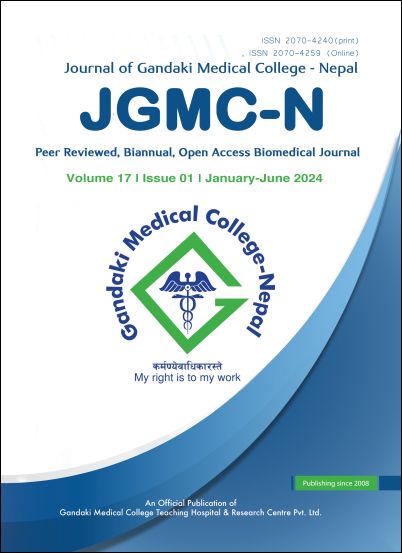Quality of life and its associated factors among the elderly population living in their own homes
DOI:
https://doi.org/10.3126/jgmcn.v17i1.62757Keywords:
Elderly people, own home, quality of lifeAbstract
Introduction: Quality of life among elderly individuals is an important area of concern that reflects the health status and well-being of this vulnerable population. Quality of life among elderly individuals is a neglected issue, especially in developing countries such as Nepal. The objective of this study was to assess the quality of life and its associated factors among the elderly population living in their own homes.
Methods: A community-based cross-sectional study was conducted among 234 elderly individuals living in the Syangja district of Nepal. Quality of life was assessed by the World Health Organization Quality of Life BREF (WHOQOL-BREF) tool. Sociodemographic data were recorded by using a structured questionnaire. Independent t-tests and multiple linear regression were performed.
Results: Among 234 respondents, 54.7% of the elderly were 60 to 69 years old and 57.7% were female. The overall mean standard deviation score of QoL was 57.80±11.89. A total of 56.4% of respondents had a fair quality of life. Multiple linear regression analysis showed that physical exercise was associated with physical, psychological and social dimensions of quality of life. Education status was associated with physical dimension, chronic disease was associated with psychological dimension and past occupation was associated with environmental dimension. Age (p-value 0.032), marital status (p-value 0.047) and physical exercise were associated with overall fair quality of life.
Conclusions: More than half of the elderly have a fair quality of life and nearly half have a poor quality of life. Age, marital status, educational status, and physical exercise are factors influencing their quality of life. Local activities and awareness should be encouraged to enhance the Quality of life of elderly people.
Downloads
Downloads
Published
How to Cite
Issue
Section
License
Copyright (c) 2024 The Author(s)

This work is licensed under a Creative Commons Attribution-NonCommercial 4.0 International License.
This license allows reusers to distribute, remix, adapt, and build upon the material in any medium or format for noncommercial purposes only, and only so long as attribution is given to the creator.




